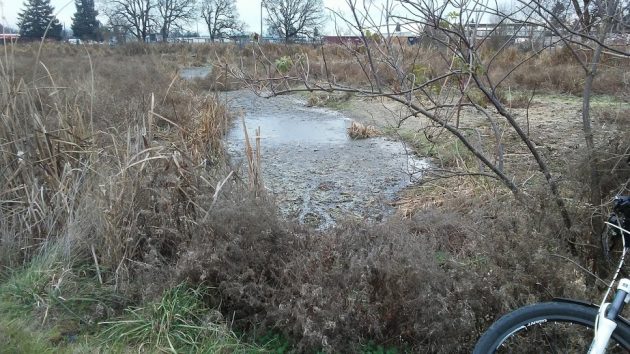
The notice at the entrance explains why the Water Gardens are not all that watery these days.
A cold and gray afternoon, like the last day of November for instance, is a good time for a cycling tour of the Talking Water Gardens. Because pedestrians are almost entirely absent on the trails.
The other thing in short supply is water. Some of the upper wetland ponds or cells are completely dry, and in others there’s only what might be called a big puddle. (See the photos below.) The water level is far down in the largest pond near the entrance too.
A notice at the enrance explains what’s going on. The water level has been lowered temporarily to allow for maintenance to be done. That’s also why the waterfalls, the normally chattering voices in these gardens, are not doing any talking for the time being.
But there’s still wildlife, not including the dog in the photo at the top, strolling out of the gardens after its owner, one of only two visitors I saw Saturday. The crunching of the bike’s tires on gravel spooked a couple of fat nutria that had been sitting on the path. They scurried into the reeds before I got close.
For the history, purpose and other details of these artficial wetlands, check the Albany city website here.
Without water, and thus without ducks and visible turtles and such, the ponds now look kind of dismal, a mass of mud and dead plants. They don’t look much like a garden.
But even with very little water and no talking falls, these gardens still are a unique Albany-Millersburg attraction with winter coming on. Especially when you can cruise the nearly two miles of trails without bothering anybody wandering about on foot. (hh)

The water level is way down in the large pond near the entrance.

Only a big puddle remains in this wetland cell near the top of the gardens.

And except for mud, this one is completely dry.


Talking Waters is unique in the garden milieu. And Hasso paints the best possible picture one might wish for in reference to the essentially dried-up, frozen-over bayou when he says, with Chamber-of-Commerce joie d vivre, “But even with very little water and no talking falls, these gardens still are a unique Albany-Millersburg attraction…”
Don’t get me wrong. I have used and enjoyed the Talking Waters garden tour on several occasions, enjoying the peace and quiet associated with the grounds. It is just good to know that Hasso Hering, a well-respected authority of sorts, is standing tall for Albany’s tourism industry amidst the garden’s dry spell.
What happens to all the turtles and such when they drain (or almost fully drain) the ponds?
I was there (on foot) Saturday with my partner and had (as always) a wonderful walk. There was one partially open pond which hosted mallards and widgeons (I believe three were somewhat unusual European Widgeons). We saw what I believe was a river otter dash across the path, under the fence and down toward one of the Simpson Park log ponds. It is a wonderful all the year around.
I am curious as to whether the “maintenance” that is being done has any relationship to the Oregon DEQ’s charge of an unauthorized leak from the bottom of the ponds, if I remember correctly of
your earlier article. Lowering the water levels would facilitate adding bentonite clay which is commonly used to seal ponds.
It would seem that a leak through the bottom would even better provide filtering and cooling of the water which I thought was the original purpose of the water garden. but I guess that would be an unauthorized “discharge” from a “source point.” no matter if it might be beneficial.
But then a good fine might be more beneficial to the cash-strapped DEQ.